WiSilica WISE1012A Wise-Connect 1012 Module 1.0 User Manual 15 WISE1012A UserMan
WiSilica, Inc. Wise-Connect 1012 Module 1.0 15 WISE1012A UserMan
WiSilica >
15_WISE1012A UserMan

WiSe 1210 Bluetooth Low Energy Module User’s Guide
WiSilica Inc Proprietary and Confidential
WiSe 1210 Bluetooth Low Energy User’s Guide
Model: WISE1012A
FCCID: 2AG4NWISE1012A

WiSe 1210 Bluetooth Low Energy Module User’s Guide
WiSilica Inc Proprietary and Confidential
Table of Contents
Introduction............................................................................................................................................3
BluetoothLowEnergyFundamentals.....................................................................................................3
Features..................................................................................................................................................4
BlockDiagramForLEDLampUsingWiSe1210MOD:............................................................................4
ProductLevelDiagram:...........................................................................................................................5
WiSe1210ModuleApplications.............................................................................................................5
SmartMeshLightApplication.............................................................................................................6
Sensor.................................................................................................................................................6
HealthSensor......................................................................................................................................9
Beacons.............................................................................................................................................10
ModulePinDiagram:............................................................................................................................10
ModulePinDescription....................................................................................................................11
ProgrammableGPIO’s...........................................................................................................................11
ADC....................................................................................................................................................11
DigitalIO’s.........................................................................................................................................11
PWM.................................................................................................................................................12
PackageDimension:..............................................................................................................................12

WiSe 1210 Bluetooth Low Energy Module User’s Guide
WiSilica Inc Proprietary and Confidential
Introduction
This chapter introduces the WiSe1210 Bluetooth Low Energy module which also
includes some fundamentals concepts of Bluetooth Low Energy (BLE). The
WiSe1210 Bluetooth® Low Energy Module is a single mode Bluetooth Smart module
that complies with Bluetooth Core Specification v4.1. WiSe1210 enables ultra-low-
power connectivity and basic data transfer for applications previously limited by the
power consumption, size constraints and complexity of other wireless standards.
WiSe 1210 module provides everything required to create a Bluetooth low energy
product with RF, baseband, MCU, qualified Bluetooth v4.1 specification stack and
customer application running on a single IC The WiSe1210 module is easy to use
and provides users with a fast-to-market, flexible, and powerful solution for BTLE
technology.
Finally, the WiSe1210 module also supports a user-defined private profile/service,
which can precisely fit a user's particular application. All configurations will be saved
in on-board non-volatile memory (NVM), so users need to set up the module only
once.
Bluetooth Low Energy Fundamentals
All BTLE device roles are built on top of the Generic Accessory Profile (GAP), which
defines the devices to be either Central, Peripheral, Observer or a Broadcaster.
When two BTLE devices need to establish a connection, one is in a central role and
the other in a peripheral role. Only central role devices can initiate a connection to
peripheral role devices. Likewise, peripheral devices are not allowed to initiate
connections. The peripheral advertises its connection status, while the central device
starts the connection process. Once connected, either end of the connection can
initiate the bond. Once bonded, all security-related keys will be saved and the
security process will be waived when reconnecting. The bonded peripheral device
can only perform direct advertise; therefore, it is no longer able to connect to devices
other than its bonded peer. Similar to Bluetooth Classic, BTLE uses the concept of
profiles to ensure interoperability between different devices. However, unlike
Bluetooth Classic, BTLE profiles are a collection of services.
All BTLE services are built on top of the Generic Attribute Profile (GATT), where
GATT defines the accessibility of attributes, which are called characteristics.
Therefore, the main functionality of BTLE profiles is built around these characteristics.
Devices that maintain the value of characteristics in a service are the “server” of the
service. Conversely, devices that acquire data from their peer are considered the
“client”. Each service and its characteristics are identified by their Universally Unique
Identifier (UUID). The UUID can either be short form (16-bit) or long form (128-bit).
All Bluetooth SIG adopted services and characteristics have a short UUID, whereas
a user-defined private UUID must be in long form. For information on the Bluetooth
SIG adopted services and characteristics, visit the Bluetooth Developer Portal at:
https://developer.bluetooth.org/gatt/profiles/Pages/ProfilesHome.aspx
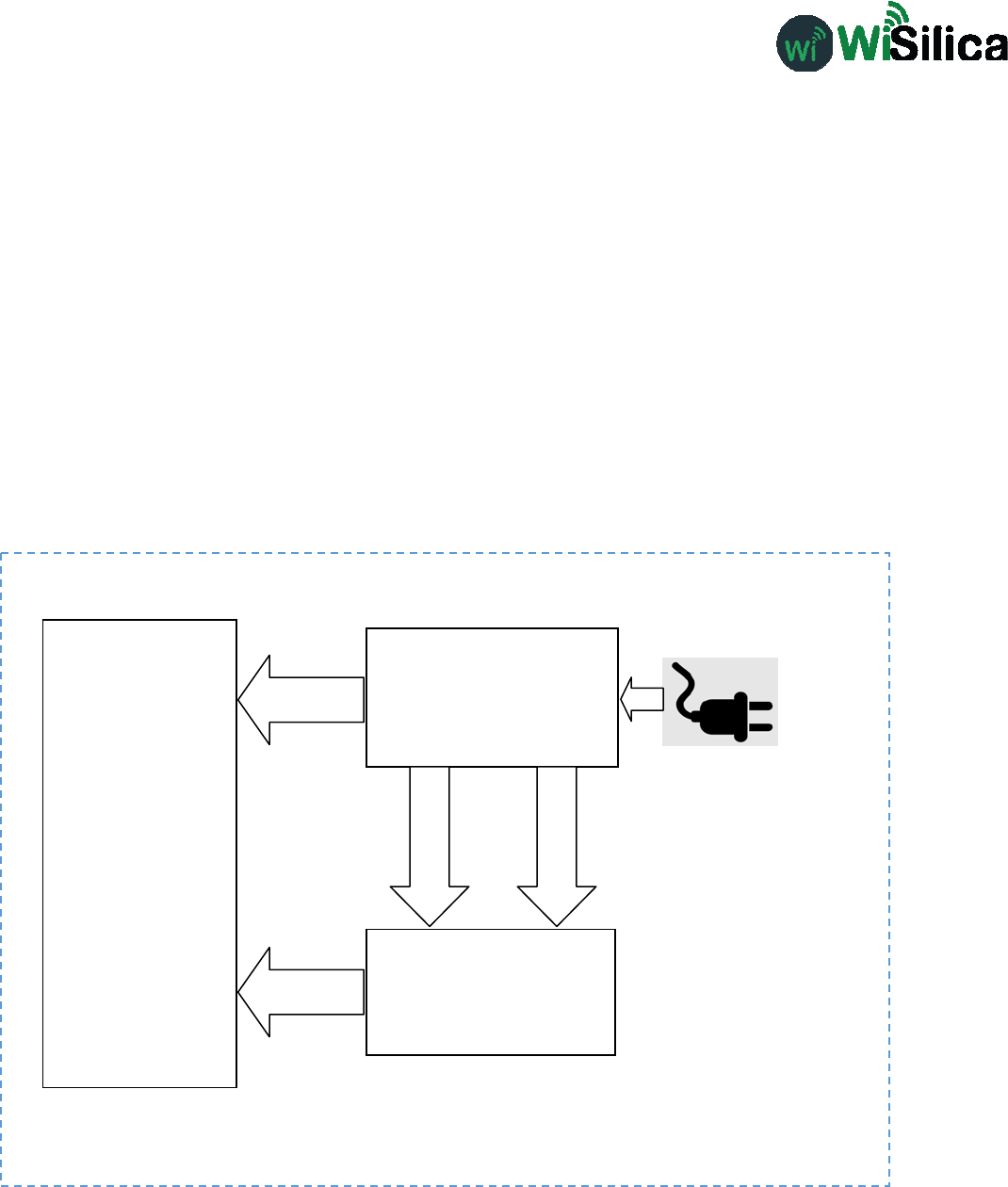
WiSe 1210 Bluetooth Low Energy Module User’s Guide
WiSilica Inc Proprietary and Confidential
Features
Bluetooth v4.1 specification complaint
Support for Bluetooth 4.1 specification host stack
64kb of RAM and 64kb of ROM
16 MHz and 32.768 kHz clock system
32.768 kHz for sleep time
PWM/SPI/GPIO/UART/I2C interface
Both PCB printed and External Antenna
8 programmable GPIO’s
1 MB EEPROM
Debug SPI
Block Diagram For LED Lamp Using WiSe 1210 MOD:
230V
LED
BOARD
LED DRIVER & AC to
DC
CONVERSION
CIRCUIT WITH 3V
OUT.
WiSe 1210 MODULE
3V
+Ve
GND
PWM

WiSe 1210 Bluetooth Low Energy Module User’s Guide
WiSilica Inc Proprietary and Confidential
Product Level Diagram:
The below images shows the product level diagram of 2 Tone LED bulb and its
assembly.
WiSe 1210 Module Applications
WiSe 1210 Bluetooth Smart enables connectivity and data transfer to leading
smartphone, tablet and personal computing devices including Apple iPhone, iPad,
iPod and Mac products and leading Android devices. WiSe1210 takes less time to
make a connection than conventional Bluetooth wireless technology and can
consume approximately 1/20th of the power of Bluetooth Basic Rate. WiSe 1210
module support the profiles for
Smart mesh light application
Smart home heating and lighting control
Health sensors like blood pressure, thermometer and glucose meter
Beacons
Security
Sensors

WiSe 1210 Bluetooth Low Energy Module User’s Guide
WiSilica Inc Proprietary and Confidential
Smart Mesh Light Application
The Internet of Things (IoT) is the interconnection of uniquely
identifiable devices within the existing Internet infrastructure. Typically, IoT is
expected to offer advanced connectivity of devices, systems, and services that goes
beyond machine-to-machine communications (M2M) and covers a variety of
protocols, domains, and applications. The interconnection of these embedded
devices (including smart objects), is expected to get used in automation in nearly all
fields, while also enabling advanced applications like a Smart Grid.
Things, in the IoT, can refer to a wide variety of devices such as heart monitoring
implants, biochip transponders on farm animals, household or commercial lighting
solution, and automobiles with built-in sensors, or field operation devices that assist
fire-fighters in search and rescue
The below figure describes the WiSe Mesh used for the WiSe Home implementation.
With the WiSe Home the user will be able to control the home globally with the
prerequisite of an internet connection and a WiSe App for your smart phone.
So all our home appliances should be incorporated WiSe1210 Module to have smart
control.
Sensor
Sensor devices are mainly used to reduce the totally power consumption which
included
• PIR Sensor
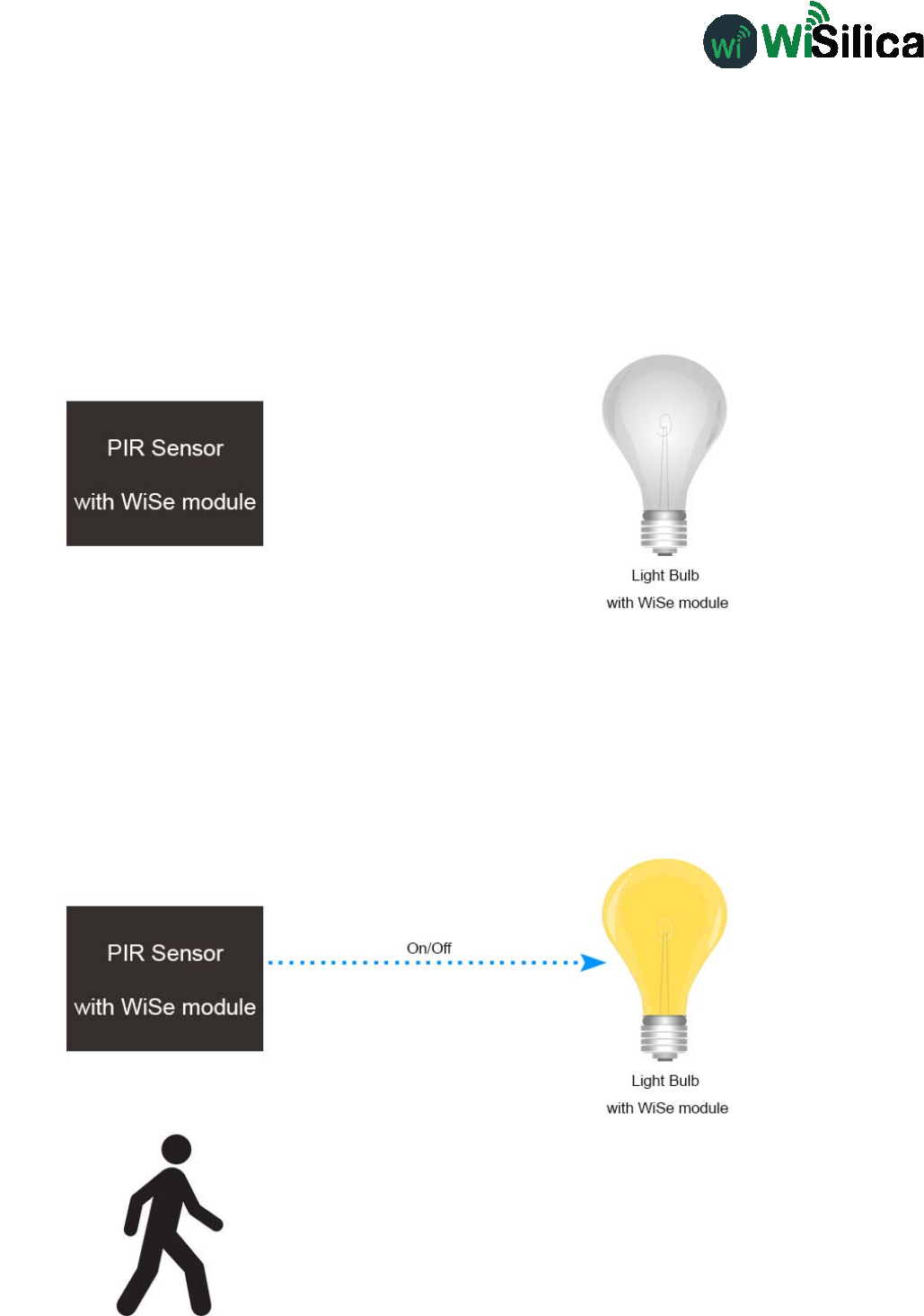
WiSe 1210 Bluetooth Low Energy Module User’s Guide
WiSilica Inc Proprietary and Confidential
• LDR Sensor
• Temperature and Humidity sensor
All the above sensors are integrated with WiSe1210 module, So once the sensor are
is get triggered it will sent it’s respective command (ON/OFF in case of PIR Sensor)
to the paired device of the particular sensor. Below figure show working Model
before and after triggering.

WiSe 1210 Bluetooth Low Energy Module User’s Guide
WiSilica Inc Proprietary and Confidential
LDR Sensor is used for the ambient light control
High Ambient Light
Less Ambient Light
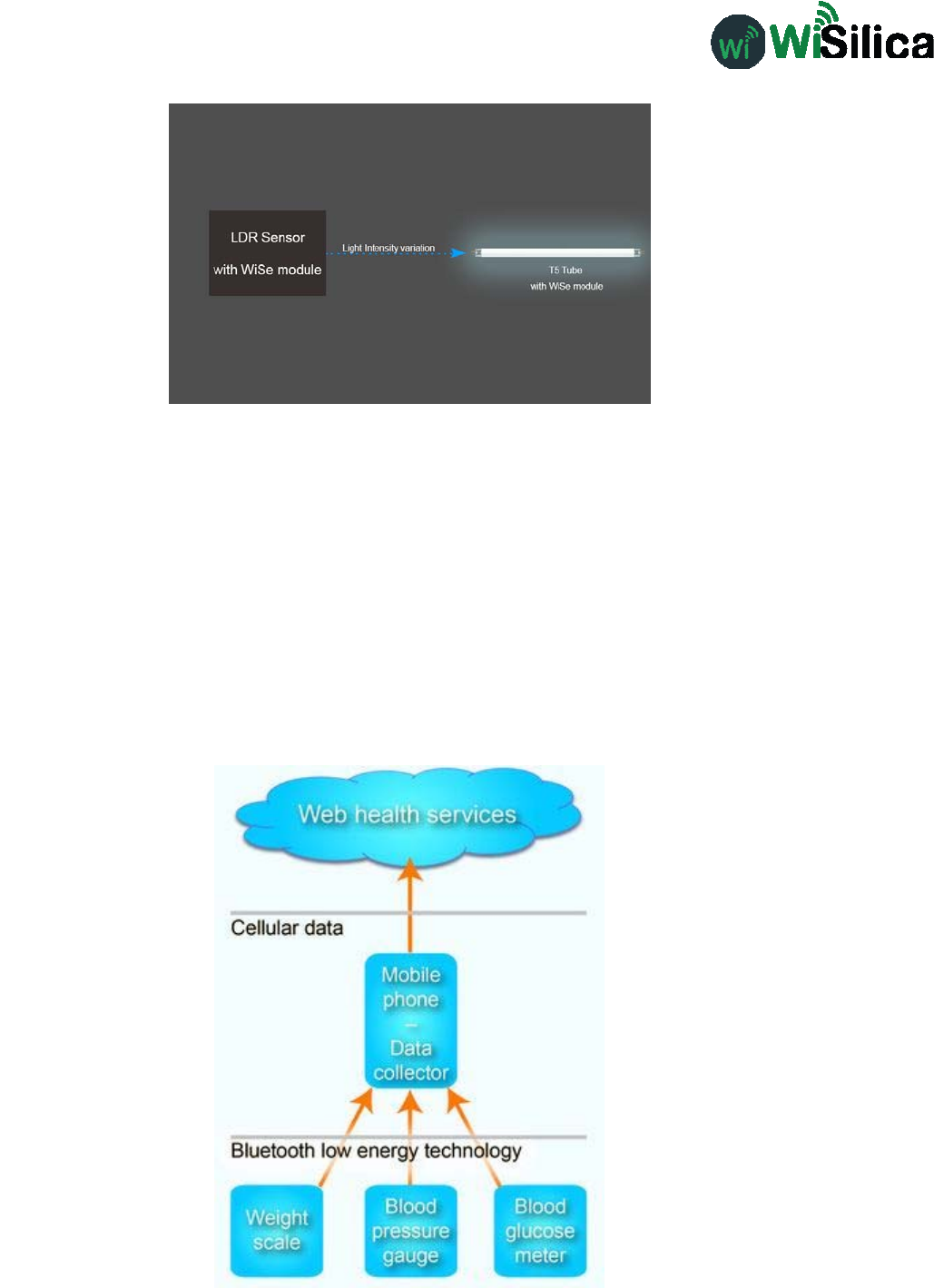
WiSe 1210 Bluetooth Low Energy Module User’s Guide
WiSilica Inc Proprietary and Confidential
Absence Of Ambient light
As shown in above image the Intensity of the T5 tube is controlled by LDR sensor
integrated with WiSe1210 module.
Health Sensor
The reduced power and cost of Bluetooth low energy technology enable many
medical use models from the home to the hospital. The example model in the home
could be used to log data and establish trends for a Congestive Heart Failure (CHF)
patient using several types of sensors and the patient’s mobile phone.
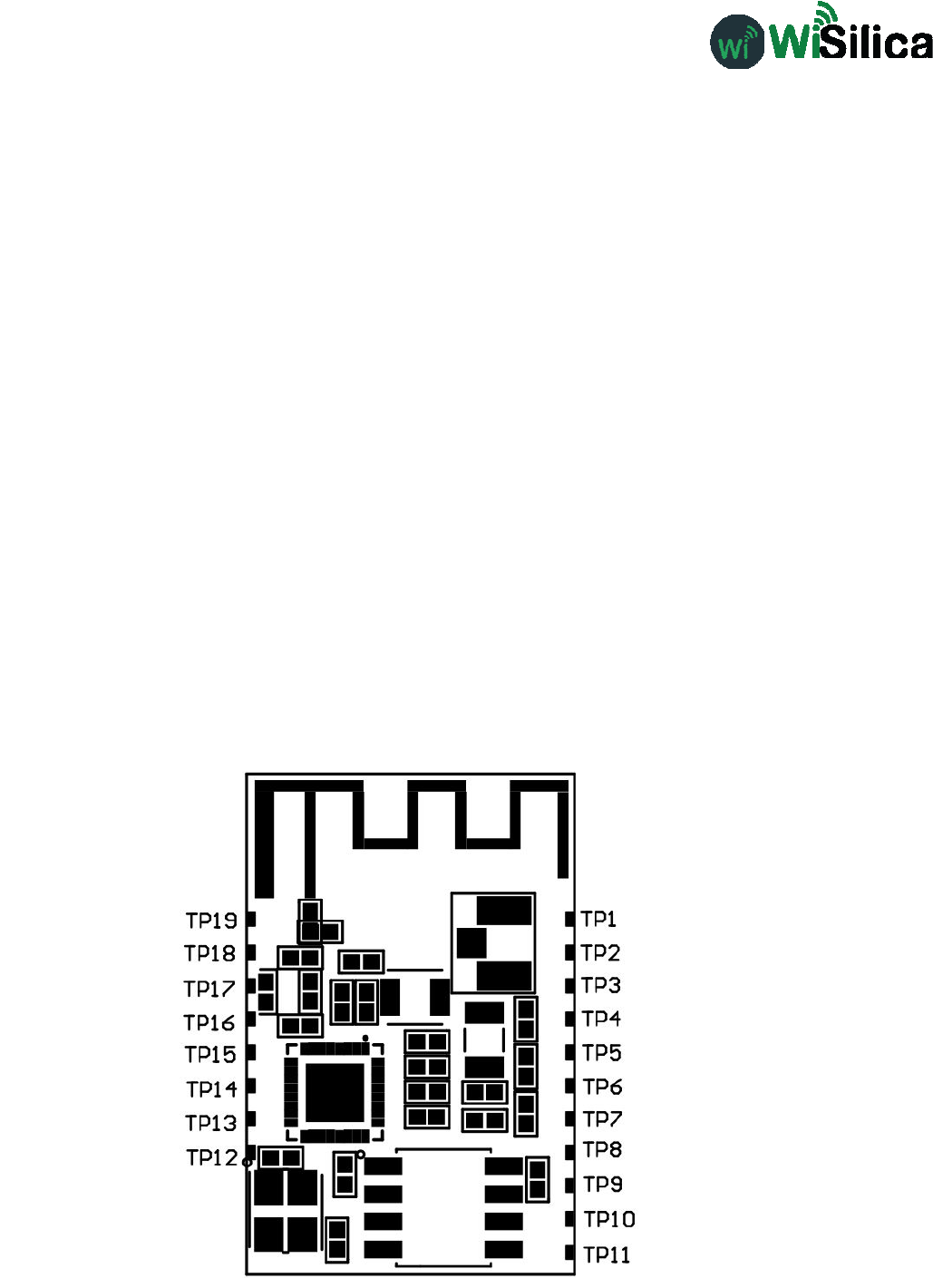
WiSe 1210 Bluetooth Low Energy Module User’s Guide
WiSilica Inc Proprietary and Confidential
As the technology is being implemented in almost all mobile devices, there is an
opportunity to utilize off-the-shelf handheld devices and enable new use models that
leverage off of the rich user interface and communication features of those platforms.
Beacons
Beacons are small indoor positioning devices that use low-energy Bluetooth (BLE) to
communicate with a shopper's smartphone in the hopes of improving the in-store
shopping experience. When placed in a store, beacons can detect nearby
smartphones and send those media such as ads, coupons, or customized
supplementary product information. Not just for shoppers, beacons can also be used
as point-of-sale systems and collect large amounts of data that can then be used to
improve both real-time and right-time marketing, in-store and online.
Some list of things that we can do with Beacon
• Control device based on the presence information
• Receive reminders when the tag moves into or out of any location
• Share location and movement information of an assets with friends and family.
• Improve the experience, sales and service based on accurate contextual
information.
Module Pin Diagram:

WiSe 1210 Bluetooth Low Energy Module User’s Guide
WiSilica Inc Proprietary and Confidential
Module Pin Description
PINSNAMEFUNCTION COMMENTS
TP1 SPI_MOSI I SPI data input or Programmable I/O
TP2 SPI_MISO O SPI data output or Programmable I/O
TP3 SPI_CSB O SPI select or Programmable I/O
TP4 SPI_PIO_SEL I Programmable I/O pulled high
TP5 3V3 Power Power Input
TP6 PIO[11] I/O Programmable I/O
TP7 PIO[10] I/O Programmable I/O
TP8 PIO[9] I/O Programmable I/O
TP9 SCL I/O Eeprom installed
TP10 SDA I/O Eeprom installed
TP11 PIO[3] I/O Programmable I/O
TP12 SPI_CLK I SPI Clock or Programmable I/O
TP13 PIO[4] O Programmable I/O
TP14 RX I/O Programmable I/O or UART RX
TP15 TX I/O Programmable I/O or UART TX
TP16 AIO[0] I/O Analog Programmable I/O
TP17 AIO[1] I/O Analog Programmable I/O
TP18 AIO[2] I/O Analog Programmable I/O
TP19 GND Ground Ground
Programmable GPIO’s
Totally 3 Analog Channels, 5 digital IO’s and 4 PWM channels are available in WiSe
1210 Module
ADC
WiSe 1210 Module supports 10bit ADC
• TP16 (AIO[0])
• T17 (AIO[1])
• TP18 (AIO[2])
Digital IO’s
• TP6 (PIO[11])
• TP7 (PIO[10])
• TP8 (PIO[9])
• TP11 (PIO[3])
• TP13 (PIO[4])
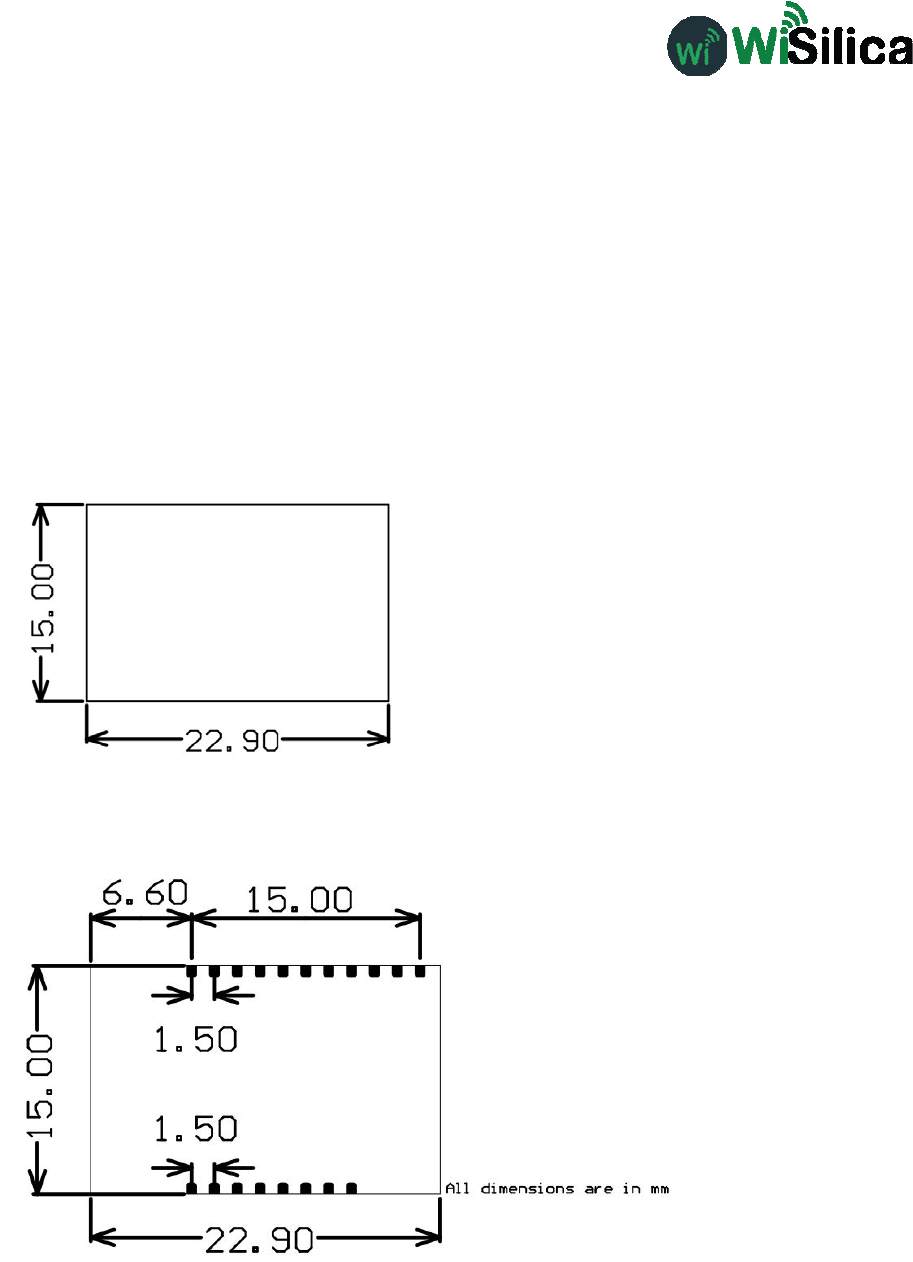
WiSe 1210 Bluetooth Low Energy Module User’s Guide
WiSilica Inc Proprietary and Confidential
PWM
Any of the Digital IO pins can be configured as PWM i.e (PIO[9] to PIO[11], PIO[3]
and PIO[4]).
Package Dimension:
Dimension: 22.9x15mm
Pitch: 1.5mm.
Pad dimension 0.7x0.77mm

NOTE: This equipment has been tested and found to comply with the limits for a Class B digital
device, pursuant to part 15 of the FCC Rules. These limits are designed to provide reasonable protection
against harmful interference in a residential installation. This equipment generates, uses and can radiate
radio frequency energy and, if not installed and used in accordance with the instructions, may cause
harmful interference to radio communications. However, there is no guarantee that interference will not
occur in a particular installation. If this equipment does cause harmful interference to radio or television
reception, which can be determined by turning the equipment off and on, the user is encouraged to try to
correct the interference by one or more of the following measures:
—Reorient or relocate the receiving antenna.
—Increase the separation between the equipment and receiver.
—Connect the equipment into an outlet on a circuit different from that to which the receiver is
connected.
—Consult the dealer or an experienced radio/TV technician for help.
Thisdevicecomplieswithpart15oftheFCCrules.Operationissubjecttothefollowingtwo
conditions:
(1)thisdevicemaynotcauseharmfulinterference,and
(2)thisdevicemustacceptanyinterferencereceived,includinginterferencethatmaycause
undesiredoperation.
Changesormodificationstothisunitnotexpresslyapprovedbythepartyresponsiblefor
compliancecouldvoidtheuser'sauthoritytooperatetheequipment.
(OEM)Integratorhastoassurecomplianceoftheentireend‐product
incl.theintegratedRFModule.Additionalmeasurements(15B)and/orequipmentauthorizations
(e.gVerification)mayneedtobeaddresseddependingonco‐locationorsimultaenous
transmissionissuesifapplicable.
Integratorisremindedtoassurethattheseinstallationinstructions
willnotbemadeavailabletotheend‐userofthefinalhostdevice.
Withthelowoutputpower,thisRFModulemeetstheFCCSARexemption
andcanbethereforeintegratedintoany(portable,mobile,fixed)host
Thefinalhostdevice,intowhichthisRFModuleisintegrated"hastobelabelled
withanauxilliarylablestatingtheFCCIDoftheRFModule,suchas
"ContainsFCCID: ".
2AG4NWISE1012A
device that powered by battery.